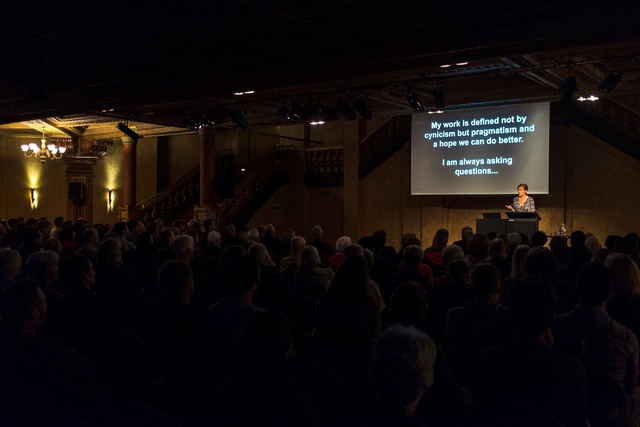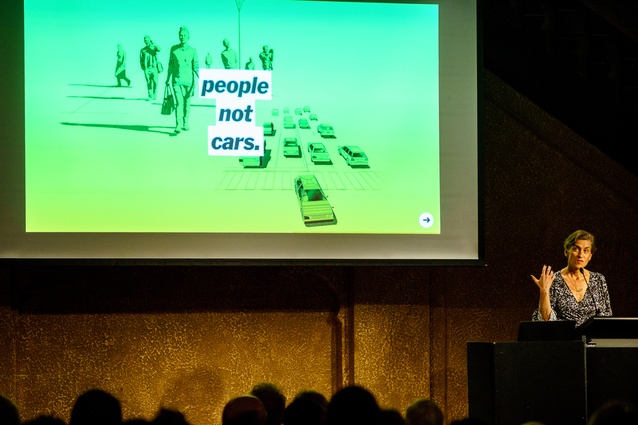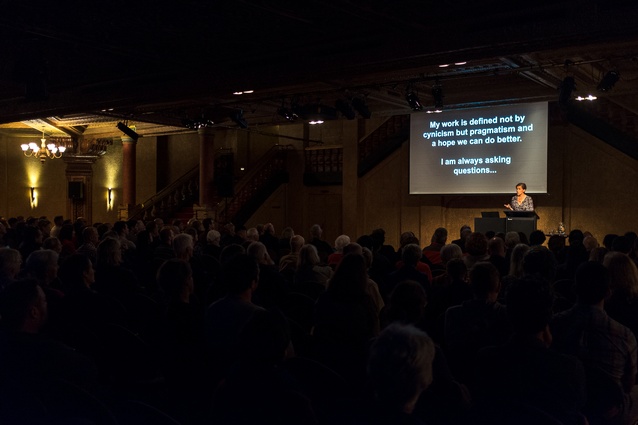Review: 2018 Sir Ian Athfield Lecture
Camille Khouri reports back from the 2018 Sir Ian Athfield Memorial lecture in Queenstown. The lecture was given by American journalist and thinker Allison Arieff as part of the New Zealand Institute of Architects' 2018 Festival of Architecture.
A small but cheerful crowd came out last night to gather in the Remarkables Primary School hall in Queenstown for the 2018 Sir Ian Athfield Memorial lecture, presented by American journalist Allison Arieff and introduced by local architect Louise Wright of Assembly Architects.
Despite a self-proclaimed lack of qualifications in either journalism or architecture, Arieff played a key role in the founding of Dwell magazine in 1999 and has written a column for The New York Times since 2007. She is currently the editorial director of The Urbanist, part of the San Francisco Bay Area Planning and Urban Research Association (SPUR), and this role was the source of a good deal of the material for her lecture.
Arieff started the lecture with some questions to the audience, which summed up a few of her thoughts on design:
“Can design solve hard problems?”
“If everything is world-changing, is anything?”
“Can a single-family home really be sustainable?”
“Can we design to influence behaviour?’’
These ideas and questions lead into the issues of her hometown. Much like the main centres of New Zealand, San Francisco has a complex mess of problems due to its exponential growth and the ever-increasing cost of living and housing (sounds familiar). Arieff described the issue of NIMBYism prevalent in the city – where residents can halt a project for any reason due to a collective cry of ‘Not In My Backyard!’, resulting in larger and much-needed housing developments not being built. By the sounds of it, the San Francisco Bay area has some similar issues to Auckland, with residents also slow to take up public transport, partly due to the complexity and unreliability of the system.

Arieff also spoke about her views on automated vehicles, a subject she authored a controversial New York Times article on. She says they cannot be relied on to save cities because any car, automated or not, takes up the same amount of space on the road, and what is really needed is for a range of options to be available and for not one of these options to be favoured.
She pointed to Apple’s headquarters, which have an allocated 1100 parking spaces, one for each of their employees, as evidence that even this forward-thinking company did not see automated vehicles as the future. She showed a slide of a village street in the 1900s – with pedestrians, horses, carts – as an example of how a shared city street allows for more collaboration and conversation between people, which is something she believes is lacking in real life.
Arieff spoke about the need for people to rediscover the public realm and for this to be done through the return of social infrastructure, such as libraries, and by promoting walking as a real mode of transport between workplaces, schools and homes. The idea of taking the street back from cars was a key take-home message here, with some examples of how this is being done by not-for-profit organisations around the USA, who are cleaning up the streets and making them safe, social places for people.
All in all, the lecture was short but sweet, with a distinct and realistic lack of answers to these complex questions, which Allison is still working through with her work at SPUR. The message was for those of us living in growing towns and cities to do some serious forward-planning and address these problems now before they become unmanageable, like they appear to be in the San Francisco Bay Area.











